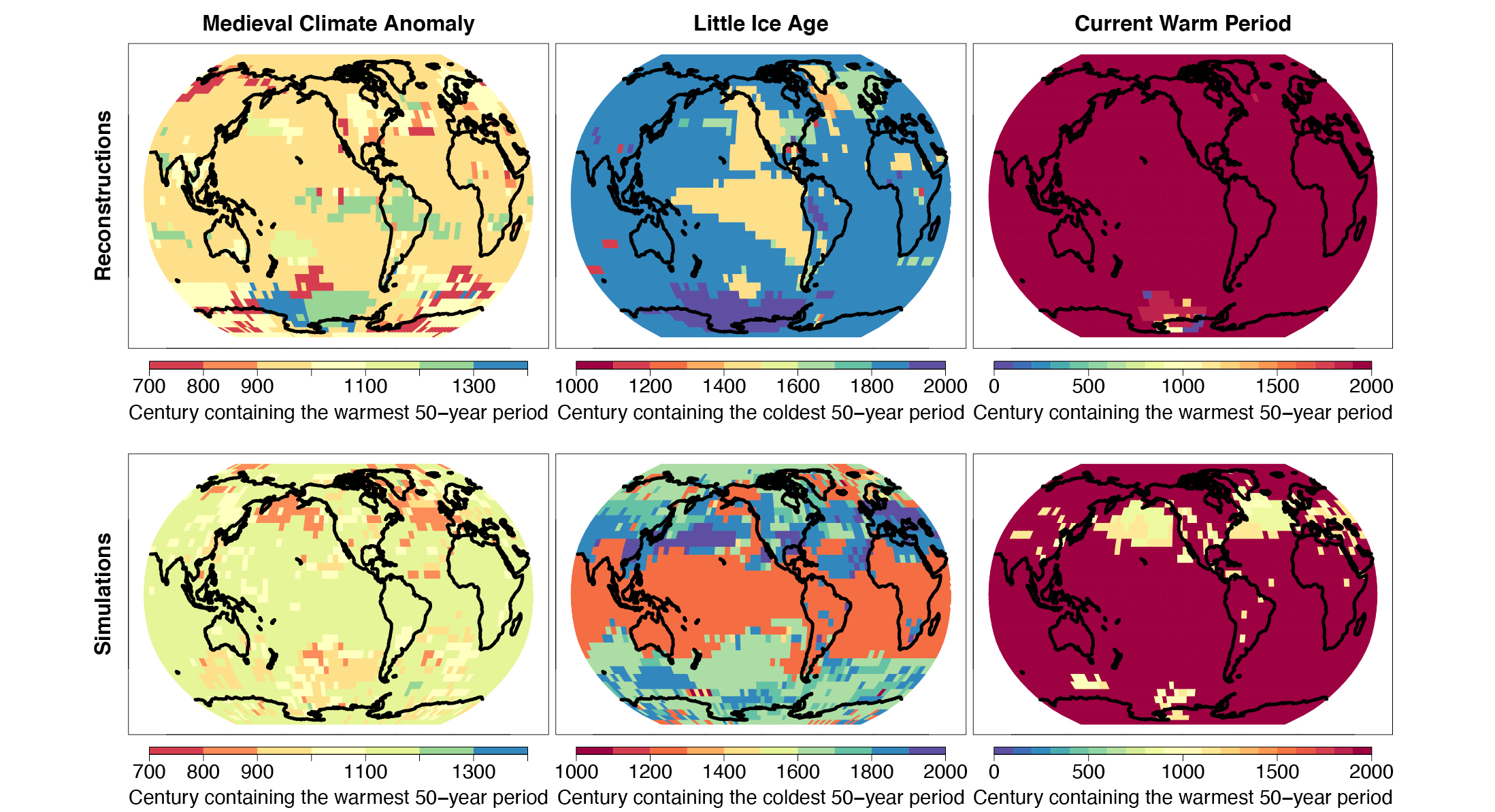- Home
- Publications
- PAGES Magazine
- Simulating The Common Era: The Past2K Working Group of PMIP
Simulating the Common Era: The Past2K working group of PMIP
Jungclaus JH, Bothe O, Garcia-Bustamante E, González-Rouco JF, Neukom R and Schurer A
Past Global Changes Magazine
29(2)
72-73
2021
Johann H. Jungclaus![]() 1, O. Bothe
1, O. Bothe![]() 2, E. Garcia-Bustamante
2, E. Garcia-Bustamante![]() 3, J.F. González-Rouco
3, J.F. González-Rouco![]() 4, R. Neukom
4, R. Neukom![]() 5 and A. Schurer
5 and A. Schurer![]() 6
6
Simulations of Common Era climate evolution coordinated by PMIP's "Past2K" working group together with multi-proxy reconstructions from the PAGES 2k Network provide pivotal understanding for the evolution of the modern climate system and for expected changes in the near future.
Transient simulations of the recent past
Knowledge of past climate evolution is essential for understanding natural variability and for providing context for current and future climate change. One example is the Common Era (CE, i.e. approximately the last 2000 years) with its vast collection of proxy, observational, and documentary datasets, which often feature annual or sub-annual resolution. Simulations covering the CE or the last millennium (LM, i.e. the 1000 years before the industrial era, 850 to 1850 CE) are essential to identify plausible mechanisms underlying paleoclimatic observations and reconstructions. Applying the same models to study past, present, and future climate and its response to external forcing enables the community to use paleodata for the evaluation of the Earth system models that we use for climate projections.
Looking back at more than 20 years of progress in the simulation of CE climate evolution, success of these experiments rests on three pillars: (1) models suitable for a realistic representation of regional and global variability and with an adequate response behavior to external forcing agents; (2) reliable estimates of external forcing factors, such as solar irradiance or volcanic sulfur injections; and (3) the availability of reliable observational or proxy-based reconstructions for model–data comparison.
Simulating 1000 years or even longer periods is challenging in terms of computational resources. Early approaches to simulate the LM have therefore applied simplified models, such as energy-balance models (Crowley 2000), or models of intermediate complexity (Goosse et al. 2005). However, starting already in the late 1990s, millennium-long simulations using comprehensive ocean-atmosphere general circulation models (like the legendary "Erik" runs; González-Rouco et al. 2003) paved the way for more complex analyses of dynamical changes and regional climate variations. Over the first decade of the 21st century, more modeling groups became interested in LM simulations (see Fernandez-Donado et al. 2013 for a review), and progress in model development allowed for more complexity to be included, for example the interactive simulation of the carbon cycle (Jungclaus et al. 2010) or ozone chemistry (Shindell et al. 2001).
Last millennium simulations in PMIP3/CMIP5
Considering the role of information from paleoarchives and modeling in the Intergovernmental Panel on Climate Change (IPCC) assessment reports (AR), the PMIP workshop in Estes Park, USA, in 2008 (Otto-Bliesner et al. 2009) suggested that coordinated simulations of the LM should receive high priority in PMIP's contribution to the fifth phase of the Coupled Model Intercomparison Project (CMIP5). Consequently, a working group was established to coordinate the experiments and to discuss a common basis for "past1000" simulations covering the period 850 to 1850 CE. Schmidt et al. (2011) provided a comprehensive protocol on which modeling groups were able to build their experimental strategy. Additionally, the adaptation of the CMIP5 data format conventions facilitated the distribution of data through CMIP's Earth System Grid Federation framework. The initiative resulted in contributions from 10 modeling groups, including institutions that were previously not active in PMIP. Several of those provided multiple realizations or sensitivity experiments using, for example, different flavors of solar forcing (Masson-Delmotte et al. 2013, Fig. 5.8).
PMIP and PAGES2k collaboration and scientific achievements
The endorsement of the LM simulation as a key experiment in PMIP coincided with the launch of the Past Global Changes PAGES 2k Network (PAGES2k; pastglobalchanges.org/2k) in 2008. Consequently, both initiatives have collaborated and profited from each other. Common work on reconstruction and model simulations was reflected at prominent places in IPCC's AR5 (Masson-Delmotte et al. 2013). For example, based on the comparison between reconstructions and simulations, the authors of AR5 concluded that there is high confidence that not only external orbital, solar, and volcanic forcing but also internal variability contributed substantially to the spatial pattern and timing of surface temperature changes between the Medieval Climate Anomaly and the Little Ice Age. The AR5 also highlighted significant differences between unforced and forced "past1000" simulations that can be identified on timescales larger than 50 years, indicating the importance of forced variability on these timescales.
The first phase of PAGES2k had a focus on regional temperature reconstructions, and a community-building workshop was held in 2013 in Madrid. The workshop led to the initiation of assessments of regional temperature responses to external forcing, and the PAGES2k-PMIP3 group (2015) concluded that the response to external forcing is detectable in the Northern Hemisphere during all time periods over the last 2000 years (Fig. 1). The role of solar forcing was investigated and found to be comparatively smaller than that of the volcanic forcing. Data–model agreement was considerably lower in regions in the Southern Hemisphere compared to the Northern Hemisphere. To understand these still substantial differences over large parts of the globe, improved proxy data coverage and understanding of dynamical processes, such as variability modes, was identified as a priority for future work.
Moving beyond temperature reconstructions and to the second phase of PAGES2k, another workshop at the Lamont-Doherty Earth Observatory in the Palisades, USA, in 2016 (pastglobalchanges.org/calendar/26535) concentrated on hydroclimatic aspects and refined best practices for model–data comparisons of hydroclimate over the CE (PAGES Hydro2k Consortium 2017). The workshop also covered novel aspects such as proxy system modeling and the interactive simulations of water isotopes as it is promoted in PAGES2k's Iso2k project (pastglobalchanges.org/iso2k).
For other PAGES2k initiatives, for example those working on sub-continental temperature reconstructions, the "past1000" multi-model ensemble was instrumental in understanding the mechanisms driving global and regional climate variability on interannual to centennial timescales. For example, Neukom et al. (2019) confirmed the lack of preindustrial spatial coherence in temperature both in field reconstructions and LM simulations (Fig. 2).
From PMIP3 to PMIP4
Preparing for the sixth phase of CMIP (CMIP6), the PMIP community designed experiments for five different periods. Among others, this included the LM, in order to address the CMIP science objectives defined by the World Climate Research Program. Fostering proper model documentation, CMIP6 introduced a new structure, where a set of common standardized experiments (e.g. idealized CO2-increase experiments) is accompanied by CMIP-endorsed experiments, like PMIP. The experimental protocol for CE simulations (Jungclaus et al. 2017) reflected refinements in the external forcing agents, in particular solar irradiance, volcanic forcing, and land-cover/land-use changes. The protocol adopted CMIP's "tiered" structure to prioritize certain simulations, e.g. requiring an experiment with an agreed-on standard forcing. The protocol allowed for innovations such as interactive aerosol modules requiring volcanic emissions rather than optical properties to be included. Modeling groups were also encouraged to provide multiple realizations of single-forcing sensitivity experiments, or to expand the temporal range of simulations to include the entire CE. Another novel aspect seen in CMIP6 is that more models include additional features, such as interactive simulation of water isotopes (e.g. Brady et al. 2019).
During the CMIP6 preparation and production phase, PMIP groups concentrated on modeling aspects; now, the new PMIP4/CMIP6 simulations are just about to be harvested by the community. For example, the first "Past2K" simulation was analyzed with a focus on the volcanically active 6th century (Van Dijk et al. 2021).
Moreover, remarkable progress was achieved by individual groups and consortia outside the PMIP working group. We name here in particular the "Last Millennium Ensemble" (LME) project by NCAR (Otto-Bliesner et al. 2016), data assimilation (DA), and DA-based reconstruction (e.g. the "Last Millennium Reanalysis Project"; Hakim et al. 2016), and DA including the reconstruction of hydroclimate (Steiger et al. 2018).
At the same time, PAGES2k is moving into its fourth phase, which will begin at the start of 2022. Community consultation so far has indicated particular interest in hydroclimate, regional and large-scale climate process, data–model integration, and proxy system modeling. Thus, given the progress in modeling during the CMIP6 phase, for example the availability of simulations over the entire CE or more isotope-enabled models, the 30-year anniversary of PAGES and PMIP appears to be an excellent time, in particular for early-career scientists, to continue cooperative research on the climate of the Common Era.
affiliations
1Max Planck Institute for Meteorology, Hamburg, Germany
2Helmholtz-Zentrum Hereon, Geesthacht, Germany
3Centro de Investigaciones Energéticas, Medioambientales y Tecnológicas, Madrid, Spain
4Department of Earth Physics and Astrophysics, Geosciences Institute IGEO (UCM-CSIC), Complutense University of Madrid, Spain
5Department of Geography, University of Zurich, and Department of Geosciences, University of Fribourg, Switzerland
6School of Geosciences, University of Edinburgh, UK
contact
Johann Jungclaus: johann.jungclaus mpimet.mpg.de
mpimet.mpg.de
references
Brady E et al. (2019) J Adv Model Earth Syst 11: 2547-2566
Crowley TJ (2000) Science 289: 270-277
Fernandez-Donado L et al. (2013) Clim Past 9: 393-421
Goosse H et al. (2005) Quat Sci Rev 24: 1345-1360
González-Rouco JF et al. (2003) Geophys Res Lett 30: 2116
Hakim GJ et al. (2016) J Geophys Res Atmos 121: 6745-6764
Jungclaus JH et al. (2010) Clim Past 6: 723-737
Jungclaus JH et al. (2017) Geosci Model Dev 10: 4005-4033
Neukom R et al. (2019) Nature 571: 550-554
PAGES Hydro2k Consortium (2017) Clim Past 13: 1851-1900
PAGES2k-PMIP3 group (2015) Clim Past 11: 1673-1699
Otto-Bliesner BL et al. (2009) Eos 90: 11
Otto-Bliesner BL et al. (2016) Bull Am Meteorol Soc 97: 735-754
Schmidt GA et al. (2011) Geosci Model Dev 4: 33-45
Shindell DT et al. (2001) Science 294: 2149-2152
Steiger N et al. (2018) Sci Data 5: 180086
Van Dijk E et al. (2021) Clim Past Discuss, doi:10.5194/cp-2021-49


